AMD's Sempron 3300+: 90nm Budget Computing
by Anand Lal Shimpi on April 18, 2005 2:10 AM EST- Posted in
- CPUs
Workstation Applications
SPECviewperf 8
For our next set of professional application benchmarks, we turn to SPECviewperf 8. SPECviewperf is a collection of application traces taken from some of the most popular professional applications, and compiled together in a single set of benchmarks used to estimate performance in the various applications that the benchmark is used to model. With version 8, SPEC has significantly improved the quality of the benchmark, making it even more of a real world indicator of performance.
We have included SPEC's official description of each one of the 8 tests in the suite.
Not too surprising is the strong performance of the Sempron here; the chip's on-die memory controller ensures very good performance in all of the SPECviewperf tests.
3dsmax Viewset (3dsmax-03)
"The 3dsmax-03 viewset was created from traces of the graphics workload generated by 3ds max 3.1. To ensure a common comparison point, the OpenGL plug-in driver from Discreet was used during tracing.
The models for this viewset came from the SPECapc 3ds max 3.1 benchmark. Each model was measured with two different lighting models to reflect a range of potential 3ds max users. The high-complexity model uses five to seven positional lights as defined by the SPECapc benchmark and reflects how a high-end user would work with 3ds max. The medium-complexity lighting models use two positional lights, a more common lighting environment.
The viewset is based on a trace of the running application and includes all the state changes found during normal 3ds max operation. Immediate-mode OpenGL calls are used to transfer data to the graphics subsystem."
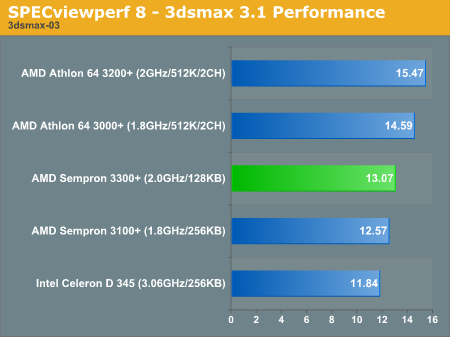
CATIA Viewset (catia-01)
"The catia-01 viewset was created from traces of the graphics workload generated by the CATIATM V5R12 application from Dassault Systems.
Three models are measured using various modes in CATIA. Phil Harris of LionHeart Solutions, developer of CATBench2003, supplied SPEC/GPC with the models used to measure the CATIA application. The models are courtesy of CATBench2003 and CATIA Community.
The car model contains more than two million points. SPECviewperf replicates the geometry represented by the smaller engine block and submarine models to increase complexity and decrease frame rates. After replication, these models contain 1.2 million vertices (engine block) and 1.8 million vertices (submarine).
State changes as made by the application are included throughout the rendering of the model, including matrix, material, light and line-stipple changes. All state changes are derived from a trace of the running application. The state changes put considerably more stress on graphics subsystems than the simple geometry dumps found in older SPECviewperf viewsets.
Mirroring the application, draw arrays are used for some tests and immediate mode used for others."
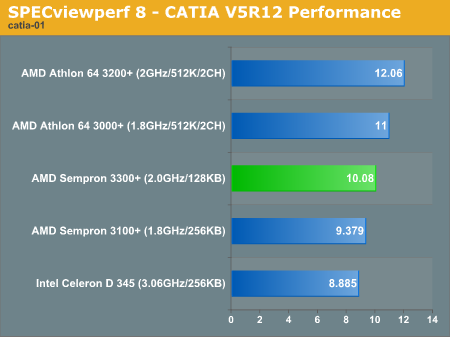
Lightscape Viewset (light-07)
"The light-07 viewset was created from traces of the graphics workload generated by the Lightscape Visualization System from Discreet Logic. Lightscape combines proprietary radiosity algorithms with a physically based lighting interface.
The most significant feature of Lightscape is its ability to simulate global illumination effects accurately by precalculating the diffuse energy distribution in an environment and storing the lighting distribution as part of the 3D model. The resulting lighting "mesh" can then be rapidly displayed."
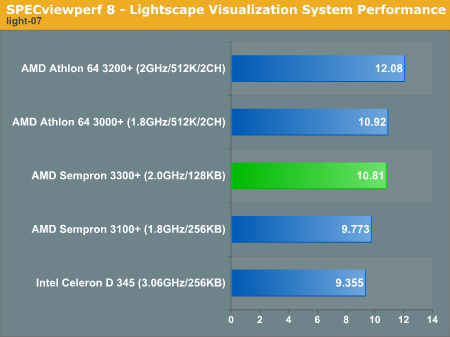
Maya Viewset (maya-01)
"The maya-01 viewset was created from traces of the graphics workload generated by the Maya V5 application from Alias.
The models used in the tests were contributed by artists at NVIDIA. Various modes in the Maya application are measured.
State changes as made by the application are included throughout the rendering of the model, including matrix, material, light and line-stipple changes. All state changes are derived from a trace of the running application. The state changes put considerably more stress on graphics subsystems than the simple geometry dumps found in older viewsets.
As in the Maya V5 application, array element is used to transfer data through the OpenGL API."
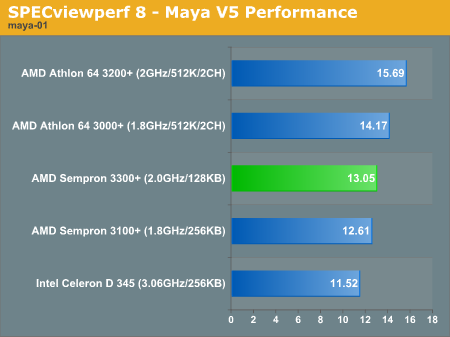
Pro/ENGINEER (proe-03)
"The proe-03 viewset was created from traces of the graphics workload generated by the Pro/ENGINEER 2001TM application from PTC.
Two models and three rendering modes are measured during the test. PTC contributed the models to SPEC for use in measurement of the Pro/ENGINEER application. The first of the models, the PTC World Car, represents a large-model workload composed of 3.9 to 5.9 million vertices. This model is measured in shaded, hidden-line removal, and wireframe modes. The wireframe workloads are measured both in normal and antialiased mode. The second model is a copier. It is a medium-sized model made up of 485,000 to 1.6 million vertices. Shaded and hidden-line-removal modes were measured for this model.
This viewset includes state changes as made by the application throughout the rendering of the model, including matrix, material, light and line-stipple changes. The PTC World Car shaded frames include more than 100MB of state and vertex information per frame. All state changes are derived from a trace of the running application. The state changes put considerably more stress on graphics subsystems than the simple geometry dumps found in older viewsets.
Mirroring the application, draw arrays are used for the shaded tests and immediate mode is used for the wireframe. The gradient background used by the Pro/E application is also included to better model the application workload."
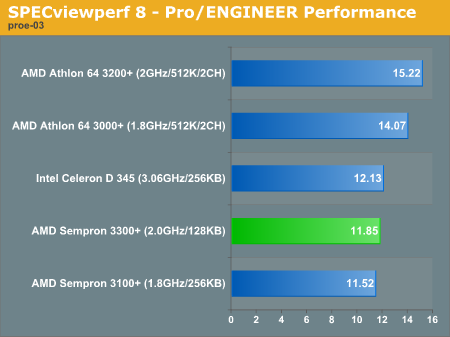
SolidWorks Viewset (sw-01)
"The sw-01 viewset was created from traces of the graphics workload generated by the Solidworks 2004 application from Dassault Systemes.
The model and workloads used were contributed by Solidworks as part of the SPECapc for SolidWorks 2004 benchmark.
State changes as made by the application are included throughout the rendering of the model, including matrix, material, light and line-stipple changes. All state changes are derived from a trace of the running application. The state changes put considerably more stress on graphics subsystems than the simple geometry dumps found in older viewsets.
Mirroring the application, draw arrays are used for some tests and immediate mode used for others."

Unigraphics (ugs-04)
"The ugs-04 viewset was created from traces of the graphics workload generated by Unigraphics V17.
The engine model used was taken from the SPECapc for Unigraphics V17 application benchmark. Three rendering modes are measured -- shaded, shaded with transparency, and wireframe. The wireframe workloads are measured both in normal and anti-alised mode. All tests are repeated twice, rotating once in the center of the screen and then moving about the frame to measure clipping performance.
The viewset is based on a trace of the running application and includes all the state changes found during normal Unigraphics operation. As with the application, OpenGL display lists are used to transfer data to the graphics subsystem. Thousands of display lists of varying sizes go into generating each frame of the model.
To increase model size and complexity, SPECviewperf 8.0 replicates the model two times more than the previous ugs-03 test."
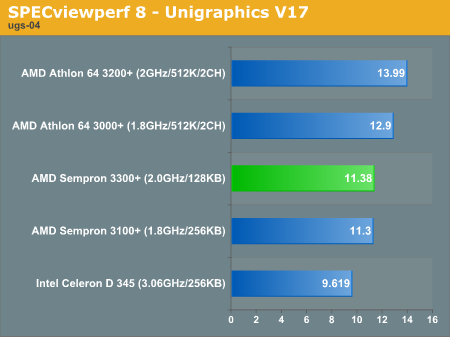










53 Comments
View All Comments
AtaStrumf - Tuesday, April 19, 2005 - link
#28 overclockingoodnessMy point exactly!!! Someone with an AXP and a 6600GT looks at those charts and thinks: "Holy crap, I really gotta get me a S939 Athlon 3200", when in reality that would be a waste of his money, becasue his GPU would be the bottleneck and a S939 chip would not be able to do $h!t for him. That's why I think, it is important to run CPU game tests with a comparible GPU, otherwise the picture is seriously distorted!
The best thing to do, would be to run both sets of tests, because running just high end GPU tests is not telling the whole story. A VERY IMPORTANT PART is missing!
Because of tests like this, I don't really know how much of a bottleneck my Athlon 3200+ S754 is or is not, when coupled with my 6600GT. Should I primarily invest in a new CPU or a new GPU? Only if I get a new high end GPU, can I actually use tests like this to tell me if I should also get a new CPU or is that just a waste of my money?
GPU tests make this same mistake, by eliminating the CPU bottleneck, by using FX-55 and co. The problem is, that by doing so, they venture in unreal territory, with, for the most part, unrealistic CPU/GPU combos. Great for theory, not so great for practice!
nserra - Tuesday, April 19, 2005 - link
I mean DUAL CORE READY.nserra - Tuesday, April 19, 2005 - link
I think this review lacks Athlon 64 with socket 754. Unless Athlon 64 with that socket is dead?Even so is not right comparing a socket 939 with a socket 754 CPU.
AMD is doing great with this new CPUs, too bad they have a bad markting machine.
Right now if INTEL WAS AMD we were already having a campain saying DUAL CORE COMPATIBLE on socket 939 boards. But no ....
alangeering - Tuesday, April 19, 2005 - link
can any reviewer give a guide as to which tests included SSE3 optimisations?This was not stated in the review.
Until the newer stepping of A64, many will not have SSE3, and so, in some media encoding tests you may have been able to show a difference between the A64 and the Semperon (in the semperon's favour).
I'm running an A64 3000 on S939, with no SSE3 support.
KristopherKubicki - Tuesday, April 19, 2005 - link
Tujan: The Lightscape benchmark comes as a portion of SPECviewperf 8.1. It is not a standalone application.Kristopher
karlreading - Tuesday, April 19, 2005 - link
This reminds me a little of a few years back when a thunderbird cost barley more than a spitfire / morgan. made the duron have no market place. AMD should keep the sempron much more crippled than the a64, to give the sempron its market and protect high end a64 chips sales / status. either that or make the lower number a64's unavalible sooner, and replace them with sempys at higer numbers.karlos
DrMrLordX - Tuesday, April 19, 2005 - link
Cool & Quiet only works for the Sempron 3000+ or higher. The socket 754 2600+ and 2800+ do not support it.cryptonomicon - Monday, April 18, 2005 - link
Man I wish there was an exciting TWIST In this article, oh well. Just looks like AMD looked to cut costs in the latest sempron and produce a more power/heat efficent processor, not much fancy :(Avalon - Monday, April 18, 2005 - link
Zebo, you know I work for stability :)Tujan - Monday, April 18, 2005 - link
Anybody Have a Link to the Program used here. To browse:"""Lightscape Viewset (light-07)
"The light-07 viewset was created from traces of the graphics workload generated by the Lightscape Visualization System from Discreet Logic. Lightscape combines proprietary radiosity algorithms with a physically based lighting interface.
The most significant feature of Lightscape is its ability to simulate global illumination effects accurately by precalculating the diffuse energy distribution in an environment and storing the lighting distribution as part of the 3D model. """....
I looked at AutoDesk but 'Lightscape,is no longer supported/obsolete. Cant be the same program. thanks.